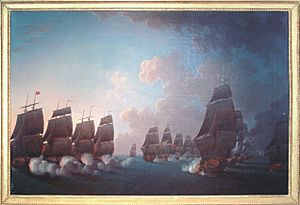Battle of Martinique (1780) facts for kids
Quick facts for kids Battle of Martinique |
|||||||
|---|---|---|---|---|---|---|---|
| Part of The American Revolutionary War | |||||||
 Combat de la Dominique, 17 Avril 1780, by Auguste Louis de Rossel de Cercy (1736–1804) |
|||||||
|
|||||||
| Belligerents | |||||||
| Commanders and leaders | |||||||
| Sir George Rodney | Comte de Guichen | ||||||
| Strength | |||||||
| 20 ships of the line | 23 ships of the line | ||||||
| Casualties and losses | |||||||
| 120 killed 354 wounded |
222 killed 537 wounded |
||||||
The Battle of Martinique was a big naval fight. It happened on April 17, 1780. This battle was part of the American Revolutionary War. It took place in the West Indies, near the island of Martinique. The British Royal Navy fought against the French Navy. The battle is also known as the Combat de la Dominique.
How Did the Battle Start?
In March 1780, a new French commander arrived. His name was Comte de Guichen. He took over from Charles Henri Hector d'Estaing. Guichen and another leader, François Claude Amour, marquis de Bouillé, planned an attack. They wanted to attack a British island in the West Indies.
On April 13, Guichen left Martinique with his fleet. He had 23 large warships, called ships of the line. He also had 3,000 soldiers. The British commander, George Brydges Rodney, was new to the area. He was based in St. Lucia.
Rodney quickly learned about the French fleet. He chased them with his 20 ships of the line. On April 16, his lookout ships spotted the French. They were west of Martinique.
What Happened During the Battle?
On the morning of April 17, both fleets started moving. They wanted to get the best position. This was called the "weather gage." It meant being upwind of the enemy. Being upwind gave a ship an advantage. It could control how it approached the enemy.
By 8:45 AM, Rodney's British fleet was upwind. They were in a tight formation. The French commander, de Guichen, saw the danger. He ordered his ships to turn north. This made his line of ships spread out.
Rodney had to move his ships again. He wanted to get back into a good position. He managed to do this by late morning. Rodney planned to attack the back and middle of the French line. He wanted to hit them hard there. He hoped to cause a lot of damage. This would happen before the front of the French line could join the fight.
Rodney sent a signal to his captains. He wanted each British ship to attack a specific French ship. This was based on how the fleets were lined up. He expected his captains to remember his earlier plan. The plan was to focus the attack on the French rear.
But something went wrong for the British. Captain Robert Carkett was leading the first British ship, HMS Stirling Castle. He either misunderstood the signal or forgot the main plan. He sailed ahead to attack the front of the French line. The rest of Rodney's fleet followed him. So, instead of a focused attack, the two lines of ships ended up fighting ship-to-ship.

The French commanders did well in this tough situation. Especially Comte de Grasse, who quickly closed up the French battle line. Because of this, de Guichen managed to escape a bad situation. The battle ended in a draw. The French goal to attack and capture Jamaica was stopped.
During the battle, Rodney's own ship, HMS Sandwich, sailed through the French line. It was heavily attacked by three French ships. These were the Couronne, Triomphant, and Fendant. They fought for about an hour and a half. Then the French ships pulled away.
What Was the Outcome?
Historians have different views on the battle. Alfred Thayer Mahan wrote that Rodney felt this battle was his big chance. He was very angry that his captains did not follow his orders. He believed their actions ruined his opportunity.
David Hannay, who wrote about Comte de Guichen, said Guichen was very skilled. He handled his fleet well throughout the campaign. Even though he didn't win a clear victory, he stopped the British. He prevented them from harming the French islands in the Antilles.
The two fleets met again on May 15. Then they met again on May 19. Both of these encounters were also draws. The French fleet went back to Fort Royal. The British fleet returned to St. Lucia and Barbados.
On July 5, de Guichen left Fort Royal. He did not join Lafayette on the American continent. Instead, he sailed for Europe on August 16. Rodney thought de Guichen had gone to Europe before hurricane season. So, Rodney sailed to South Carolina. He arrived at Sandy Hook on September 14. Rodney returned to the West Indies on November 16.

